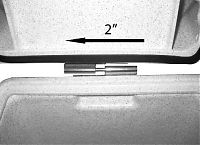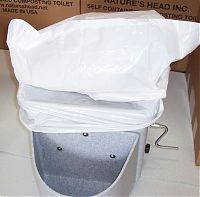How To Prepare Nature's Head Composting Toilet For Use And Maintenance
Using Your Nature's Head
The waterless, urine separating design contributes the extraordinary holding capacity. The composting section holds approximately 60 to 80 uses.
The time frame to empty the solids bin varies with number of people and the time period. The toilet is designed for 1 to 4 people full-time. Generally, two people full-time people's usage will require emptying approximately every 3 weeks; additional people will shorten the time. If using just on weekends with 2 people, that can extend time to 2 months or more. Just a couple of days of non-use extends the period of time. Usually, the level of the compost will not increase; if it does it will be minimal.
The urine bottle holds 2.2 gallons and will require more frequent emptying; two people might need to empty after 3-4 days.
 Before use, it is necessary to add compost material to the base of the unit. Gallon size "ZIPLOC" type bags are an inexpensive manner for storing the medium. To fill your toilet or refill it after emptying, pour two one-gallon bags of pre-moistened sphagnum peat moss or coconut fiber into the base of the toilet. The sphagnum peat moss should rise to the level of, or cover, the agitator bar in a horizontal position.
Before use, it is necessary to add compost material to the base of the unit. Gallon size "ZIPLOC" type bags are an inexpensive manner for storing the medium. To fill your toilet or refill it after emptying, pour two one-gallon bags of pre-moistened sphagnum peat moss or coconut fiber into the base of the toilet. The sphagnum peat moss should rise to the level of, or cover, the agitator bar in a horizontal position.
The sphagnum peat moss should be damp and crumbly, never wet or soupy. If your sphagnum peat moss or coconut fiber is dry, add a small amount of water. When not in use, the lid of the toilet should be in the closed position, preventing the entry of insects and allowing proper ventilation. The peat moss must be regular/organic sphagnum peat moss, no additives. DO NOT use MIRACLE-GRO peat moss.
Do not add additional medium after solids usage. Doing this will result in too much sphagnum peat moss or coconut coir in the unit and will limit your time of usage before emptying.
The primary concept of our composting toilet is the separation of liquids and solid wastes! Be sure to inform your guests as to the proper use of your head. This will allow proper composting action and assist your guests in feeling comfortable with a new piece of equipment.
Allowing the overflow of urine into the composting chamber will cause unpleasant odor and prevent proper compost action.
Seated usage is recommended. While seated, the unit may be used with the trap door in the open or closed position. Whether male or female, the user's liquids and solids will be directed to the correct locations from this position. With any bowel movement, the trap door must be open. Male stand-up usage is less acceptable as splatter may result. In the event that the unit is used in a standing position, the trapdoor must remain closed in order to prevent mingling of liquid and solid wastes.
Toilet paper is typically placed in the toilet. Since paper products do not decompose as quickly as solid wastes, they will be visible long after the solid matter has broken down. Any type of toilet paper is acceptable; less substantial brands (such as marine or RV paper) will compost the quickest.
Diapers, wipes and tampons should not be placed in the solids bin. Many brands of these items are made from a mix of rayon and non-organic cotton, and are commonly chlorine-bleached. These will not decompose.
Most users keep a small spray bottle (included) filled with a mixture of water and 2 oz of white vinegar nearby to spray off the bowl in the event that some solid waste adheres to the bowl. Spritzing of the bowl also assists in cleansing the urine passages.
All urine has an odor. It will not be noticed with normal use. It will be present when the storage container is open to the air for emptying. For persistent urine odors in the container, add a few ounces of white vinegar, and/or a few drops of Dawn dishwashing soap to reduce this odor.
After solid waste addition, the sphagnum peat moss or coconut fiber must be agitated 2-3 revolutions slowly in order to mix the waste into the compost and promote the composting process. Contents of the solid waste container must be kept moist, not wet, and remain separated from the liquid waste.
When the toilet is functioning correctly, the composted matter will have a musty or soil-like odor and the visual appearance will be very similar to that of the original sphagnum peat moss. It is not normal for the compost to be wet or for there to be odor problems
If the compost is staying wet and you have odor problems, the solids tank is becoming contaminated with urine and steps must be taken to prevent this. If this persists, and you are unable to determine how it is becoming contaminated, please contact us for help.
Vomiting and diarrhea, if not persistent, are unlikely to affect the head function. If increased wetness of the compost results, the situation may be corrected with the addition of a small amount of dry compost medium.
Emptying
The liquid waste vessel will contain approximately 2.2 gallons of urine. The translucent material of the container allows easy visualization of the liquid level.
To empty the liquid waste container:
1) Release the latches located at both front sides of the unit which secure the bowl to the base, 2) Raise the bowl to an angle of approximately 45 degrees, install the cap, and remove the bottle, 3) Dispose of the contents in an appropriate manner. The urine bottle maybe emptied into a conventional toilet or other appropriate facility. Many books and articles have been written on the benefits of using diluted urine as a fertilizer. This may also be part of your environmental plan for disposing of wastes in a cabin situation.
Should overflow of the liquid waste container occur, the liquid will remain confined to the container base so long as the overflow is not excessive. The liquid tank should be emptied frequently and rinsed with water with detergent or vinegar added. Allowing urine to remain in the storage container for extended periods is unwise as this will result in increased odor production. If the toilet is used in combined bathroom/shower, you may wish to drill a drain hole in the urine tank holder if water accumulation becomes a problem.
With the bottle assembly removed, lift the seat unit several inches and slide it to the left to disengage the slip hinge. (You may need to unhook your vent hose and power supply if it is necessary to move the bowl to the side.) Remove the knobs from the mounting brackets at each side of the base and the base is now ready to empty.
One of the simplest methods to empty is to place a 13 gallon kitchen bag over the opening of the base (NOTE: the bag does NOT go in the base.) The bag should fit tightly over the rim and allow you to invert the base and empty the contents into the bag without spillage. This is especially useful when the toilet is used for boats and other mobile units, as removing the toilet is unnecessary.It is unnecessary to clean the interior of the solid waste container as composting will continue from the residual matter clinging to the sides.
Cleaning the base unit, especially with any chemicals, may inhibit its ability to generate the good bacteria that is breaking down the solid wastes. Simply empty, put in more sphagnum peat moss, and re-assemble your toilet.
It is best you do not leave the liquid wastes in the tank for extended periods. While everyone is different, some urine will smell bad if allowed to sit for extended periods.
Disposal
The recommended procedure for disposing of the contents of the solid waste tank is placing it in a proper composting bin to allow it to fully decompose. When traveling in a boat or RV, this may not be practical. The contents of the solid waste tank may be safely placed into a conventional dumpster if it has been allowed to compost fully. When fully composted, the solid wastes may be used to fertilize non-ingestible plantings. Placing human waste compost on edible plants or vegetables is not recommended.
Full-time users have some special circumstances to deal with. Full-time use does not allow enough time for the solid wastes to compost. The most recent waste, although mixed with the already composted material, will not be decomposed. This also means that the fecal bacteria (present in fresh human wastes) may still be present. We recommend taking precautions such as the use of gloves if you may come into contact with waste material. It is advisable that you delay emptying the solid waste for 6-8 hours after the last use.
Another method for dealing with non-composted wastes (if space allows) is to purchase the Extra Base option and swap out the bases. The extra base comes complete with all the necessary hardware, agitator, and bottle holder. It also comes with a vented lid so the contents can be set aside and allowed to compost. A storage bin utilizing the trash bag method of emptying, placing the bag into a small plastic bucket, ventilating the lid, then allow it to finish composting may be constructed. In a cabin setting, contents could be emptied into a traditional compost bin and allowed to finish there. Solids that have not fully composted for at least a year are not suitable for use on ingestible plants.
Cleaning and Maintenance
A quick spray of water and white vinegar or a natural cleaner from the squirt bottle (included) is all that is needed to keep your NH fresh between uses. If necessary, a moistened paper towel (no synthetics) is excellent for cleansing the interior (as well as the exterior) of the head.
For more intensive cleansing or dried-on matter, a paper towel moistened with a 1:1 solution of vinegar and water may be used, and disposed of, in the same manner, after cleaning. Bleach, ammonia, and other commercial cleaning compounds should never be added to your composting head as they will interfere with the composting process and may lead to unpleasant odors. These cleaners maybe used to clean the exterior surfaces.
Maintenance requirements for the head are very minimal. All metal parts (bolts, hinges, latches, knobs, agitator, and trapdoor components) are either stainless steel or brass. Filters on each side of the base should be removed and cleaned yearly or when emptying the solid wastes. Each filter is secured to the housing with 2 Phillips-head bolts. Remove the bolts, clean and replace. Caution should be taken so that the fan is reinstalled with the airflow exiting the unit.
The full-size molded-in seat of the head is designed for safety and comfort and requires no special care.


